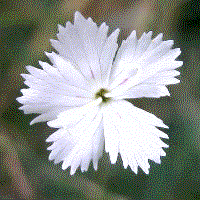 |
CARYOPHYLLACEAE - The Pink Family
This is quite a large plant Family, with about 2000 species in 80 genera. They are mainly temperate herbaceous plants, and include many popular garden plants - the Pinks, Carnations and Sweet William (Dianthus), Baby's Breath (Gypsophila), Campions and Catchflies (Silene and Lychnis) and Sandworts (Arenaria), as well as a number of weeds, including several types of Chickweed (Stellaria), Mouse-Ear (Cerastium) and Pearlwort (Sagina). They seem to do particularly well on chalky soils. The plants of this family are relatively uniform, so are easily recognised. |
Characteristics of this Plant Family:
Leaves, Stem & Roots ~ The stems are usually herbaceous, dying back to a crown in winter, although some are evergreen, and some are shrubby with persistent woody rootstocks. The leaves are almost always undivided and opposite, and the stem is swollen and easily broken at the nodes. The leaf bases are often joined around the joints to make them perfoliate, but there are usually no stipules.
Flowers ~ The flowers are regular, with a calyx of four or five free or joined lobes. There are also bracts under the flowers, particularly in Dianthus. The flowers have four or five free petals, often notched or deeply cut. There are usually twice as many stamens as petals.
Seeds ~ The ovary is superior, and the fruit is a capsule containing many seeds. The seeds are variable. In some species they are round balls, and in others they are more like flat discs.
(Click here for more information and examples of seedpods in this Family.)
Members of this Family usually have:
Swollen leaf joints
Simple undivided leaves
A calyx with five lobes
No stipules
Flowers with four or five petals
White, pink or red flowers - rarely yellow, but never blue
and are usually short annual or perennial herbs